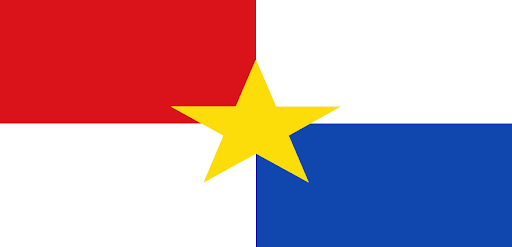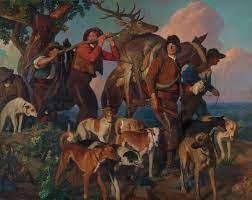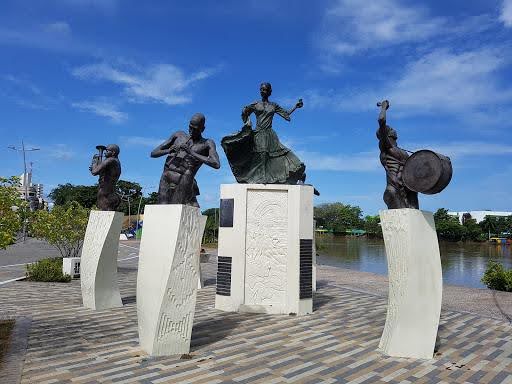Monteria
Department

Flag of the city
Flag of the city of Monteria (Córdoba). Just like the coat of arms, the flag was adopted by on June 9, 1960, by the mayor’s office. Its design was in charge of Mario Arbeláez Ceballos. The flag is divided into four parts: the upper left rectangle in red symbolizes vigor and heroism. The upper right and lower left rectangles in white represent peace. The lower right rectangle, in blue, is a symbol of the sky and space. In the centre of the flag is a golden five-pointed star that symbolizes the gold of the great Sinú.

Seal of the city
Coat of arms of the city of Montería (Córdoba). “The coat of arms of Monteria was designed during the administration of the lawyer Rafael Yances Pinedo, who commissioned the head of general affairs of the Monteria mayor’s office, Mario Arbeláez Ceballos, to design the coat of arms and the flag of the municipality. The coat of arms was adopted by Decree 076 on June 9, 1960, by the municipal mayor’s office. At the top of the emblem, there is a jaguar, a magical-religious symbol of the Zenúes. The coat of arms has two quarters. The upper one contains a lyre on a blue background, symbolizing the musical sentiment of the people of Monteria. The lower quarter shows two hands offering the fruits of the land and a blue stripe in the middle of a green background, representing the Sinú River and its valley, respectively. On the white border, the phrase MONTERÍA CARPEANT TUA POMA NEPOTES is inscribed, a Latin expression that means Monteria, may your children harvest your fruits?

Slogan of the city
“The City of the Swallows,” or “La Ciudad de las Golondrinas” in its original Spanish, beckons with a tale as poetic as its name. Nestled amidst nature’s embrace, this city stands as a testament to the harmonious coexistence between urban life and the wilderness.
Swallows, with their characteristic swift flight and iconic forked tails, don’t just visit this city; they symbolize it. These birds, celebrated as heralds of spring in cultures worldwide, have become emblematic residents, gracing the skies with their nimble aerial dances.
History
The region that is now the Department of Córdoba was originally inhabited by the Zenú Indians, who settled near three riverbanks: the Sinú (Finzenú), the San Jorge (Panzenú), and the Nechí (Zenúfana). On May 1, 1777, Spanish officer Antonio de la Torre y Miranda, under the governance of the Province of Cartagena officer Juan de Torrezar Díaz Pimienta, founded Montería. Initially located on the Sinú river’s east side and called Monteria by its settlers, it was later renamed “San Jerónimo de Buenavista” and shifted to the river’s west side.
Antonio de la Torre y Miranda named the city San Jerónimo de Buenavista to honor Saint Jerome. However, locals continued to call it Montería. In 1803, after a native group burned down the city, inhabitants relocated to the Sinú’s east bank, where it still stands. Although, in recent times, there’s been a surge in the population on the west bank. By 1923, Montería had become a municipality within the Bolívar Department. It wasn’t until 1952 that Montería separated from Bolívar and was named the capital of the newly formed Department of Córdoba.
Currently housing around 400,000 residents, Montería ranks among Colombia’s ten major cities. It’s fondly referred to as La Perla del Sinú, or The Pearl of the River Sinú.

Geography of the city
Positioned in the northern plains of Colombia, Montería, the esteemed capital of the Córdoba Department, is anchored at approximately 8.75°N latitude and 75.88°W longitude. It’s cradled by the Sinú River valley, a vital waterway that’s much more than a mere geographical feature for the city. Historically, this river has facilitated transportation and trade, and its fertile surroundings have become key agricultural zones, catalyzing the region’s economic growth and sustaining its diverse population.
With an elevation of about 18 meters (around 59 feet) above sea level, Montería experiences a warm, humid climate typical of Caribbean inland areas. Such conditions encourage verdant landscapes and underline the city’s ecological and agricultural prominence.
Montería’s unique geographical stance, marked by its proximity to the Sinú River, its tropical lowland climate, and its role connecting the Caribbean coast with the heart of Colombia, underscores its regional and national significance.

Population
446,000(2023)
440,000(2022)
433,000(2021)
In recent years, Monteria has experienced steady population growth. In 2021, the city recorded a population of 433,000 with a growth rate of 1.64%. The following year, 2022, saw an increase to 440,000, reflecting a 1.62% growth rate. As of 2023, the population has further risen to 446,000, albeit at a slightly decreased growth rate of 1.36%. This trend indicates the city’s consistent appeal and its capacity to sustain and attract more residents over the years.
One photo representative of the city
The Ronda del Sinú, a picturesque linear park in Montería, Córdoba, stretches gracefully along the eastern bank of the Sinú River. Incepted during the tenure of Mayor León Fidel Ojeda in 2005, the park spans approximately 4 kilometers and is a sanctuary for diverse wildlife, from iguanas and sloths to squirrels and a multitude of monkeys, all set against the backdrop of the region’s distinctive tropical dry forest. Historically, until around 1952, the Sinú River was a vital conduit for both cargo and passenger transportation. It not only connected riverbank towns like Tierralta, Montería, San Pelayo, Cereté, and Lorica but also served as a significant trade route to the city of Cartagena de Indias, primarily via the port of Lorica. Today, the Ronda del Sinú, stretching from 21st Street to 41st Street, seamlessly connects with the Segundo Centenario Bridge. Garnering recognition as the world’s largest linear park, it has been spotlighted in numerous media features and has piqued the interest of mayors across the nation, keen to emulate its success. The park itself is a conglomerate of varied attractions: the serene Ecological Zone rich in biodiversity; the Cultural Zone with its museum, open-air exhibits, and theater; the lively Active Recreation Zone equipped with children’s playgrounds, restaurants, and amenities; and the Artisanal and Renewal Zone, a harmonious blend of nature and commerce towards the northern end. Especially during Christmas, La Ronda becomes a beacon of festivity, its landscape adorned with radiant lights, drawing in both residents and tourists. Moreover, the park’s extensions, the ‘Ronda del Norte’ inaugurated in 2010 and the ‘Western Ronda’ introduced in 2017, continue to add to its allure, each bringing unique features and attractions while echoing the essence of the original Ronda.


Etymology
Montería, located in northwestern Colombia, serves as an inland port on the Sinú River. The city’s history traces back to 1744 when a Spanish conquistador, Juan de Torrezar Díaz Pimienta, staked a claim on a Zenúe Indian village and renamed it San Jerónimo de Buenavista. Over time, because of its reputation as a gathering point for hunters, it adopted the name San Jerónimo de Montería, which is simply translated as “Hunting” in English. By 1784, Antonio de La Torre y Miranda established it as a municipality. However, not long after its establishment, the Zenúes burned its structures. In response, the Spanish governor assigned Pedro Pardo, a Franciscan friar, to oversee the city’s restoration. Pardo’s diligent efforts led to the elevation of Montería as a diocesan see. Today, the city thrives on activities like stock raising, lumbering, placer mining, and the production of commodities such as quinine and tagua nuts, which are popularly known as vegetable ivory.
What the city is known or famous for
The city and region are known for their distinct cultural heritages. Its cultural fabric is embroidered with influences from colonial Spanish settlers, the indigenous Zenú community, Crypto-Jews, and newer waves of Middle Eastern immigrants.
The Sombrero Vueltiao stands out as a proud emblem of Montería’s heritage. Beyond just representing the city, this intricately designed hat has become a national symbol of Colombia. The heart and soul of the region also resonate in the melodies of Porro folklore music, a traditional genre that encapsulates the city’s multifaceted cultural influences.
Geographically, Monteria holds strategic significance with its inland port, linking it to the vast Caribbean Sea through the Sinú River. This connection has been instrumental in boosting trade, catalysing cultural interactions, and influencing the region’s economic trajectory.
In essence, Monteria is more than just a city; it represents a harmonious blend of varied cultures, traditions, and legacies that together paint a vivid and dynamic tapestry of life.

